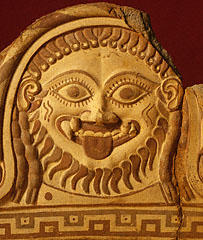Description of the Piece of Art
The J. Paul Getty Museum based in Los Angeles houses various works of art that range from paintings, drawings, sculptures, and European, American photographic works. The museum also has artworks from ancient Greece, Rome, and Etruria among other artistic works.
One of these works includes an Etruscan Terracotta fragmentary roof ornament that has an image of Medusa that was created in 550-500 B.C. This piece of work is available in the museum’s Getty Villa that is located in the Malibu area of Los Angeles.
This art piece is depicted by a monstrous gorgon form that makes it be classified as a fragmentary antefix. “An antefix is defined as a roof tile that runs along the eaves of a building that ended up to be a decorated element of art” (Getty par. 1).
The Gorgon in the art sculpture was meant to ward off any evil presence in the building where it was placed. The diagram below represents an image of the fragmentary roof ornament in the J. Paul Getty Museum

(Source: Getty par. 1)
Review of the Features in the Art Form
The artist of the fragmentary roof is unknown, but his depiction of Medusa’s beard, bulging eyes, fangs, and her protruding tongue was meant to depict her scary appearance from the famous Greek mythologies.
The artist has also used two shades of red paint to enliven Medusa as monster where the different shades of paint and the bright colors help to increase the visible features of the monster for those who are viewing the ornament from below.
In the original piece of the art form, the gorgon head was framed by a shell that is now mostly broken, but artistic scholars have been able to determine when and where this piece of artwork was created through an analysis of the shell.
According to scholars, the shell framing was a major element of Campanian creations which began around 550 BC (Getty par.2).
Many of the Greek ideas incorporated into the ornament were adopted from native artists who existed in Italy during the same period some of whom included Etruscan artists based in the northern parts of Italy and the Greeks based in the south.
Artistic scholars have been able to trace the shell to date back to 550 to 500 BC because of the short flat shape that is found in the grooves of the shell.
The Gorgon of Medusa depicts the amazing fruition of Medusa from her early archaic depictions of a beautiful woman to her later depiction of a monster in the 4th-century art forms.
Over many centuries, the Gorgon of Medusa is transformed from that of a beautiful woman to that of a hideous monster in various art forms such as the fragmented ornamental roof (Serfontein 37).
Meaning Derived from the Art Work
This piece of work falls under the classical pieces of artwork done by ancient artists where the artist visualizes Medusa as a transitional creature because the ornament does not include the snakes on her head.
The fragmented ornament has included her grimacing mouth that has been portrayed in different shades of red, her protruding tongue, and her animal-like nose that all demonstrate features of transformational art.
Medusa’s moon shape has been maintained which is evidenced by the rounded contour of the shaped face in the fragmented ornament.
This was a major characteristic of many of the artists who used Medusa’s form in the mid-fifth century, and that demonstrates that this piece of art was created in the period of 550 to 500 B.C.
This piece of art is also classified to be from the mid-fifth century because of the artist’s mastery of perspective as the ornament occupies a three-dimensional space on the roof.
According to Chiaro (53) in his description of the piece of art, the captivating head of Medusa was carefully carved into the stuff of the roof ornament that was made of porous volcanic stone, which was common in various parts of Etruria.
Chiaro further notes that Medusa’s face has been sculpted by the unknown artist to be fleshy and wide with a broad nose and deep set eyes as well as a full and slightly parted mouth with red lips.
These were all common features of Hellenistic features that many Etruscan used in their art forms during the mid-fifth century BC (Chiaro 53).
The fragmented ornament was designed in a way that was meant to represent the three-dimensional frontal protruding heads that were a common feature of many Etruscan arched hallways and gateways during the fifth century.
The formal elements of the artwork are meant to represent the transformational image of Medusa as a monster and also as a woman.
This fragmented piece of work as mentioned in the beginning was believed by scholars to be designed by the artist to ward off any evil spirits that might exist within the building were this ornament would be placed.
The use of bright colors such as red was meant to depict Medusa’s head like a monster and also as a woman going through a transformational change.
Works Cited
Chiaro, Mario D. A monumental Etruscan Medusa Head. The J. Paul Getty Museum Journal, 9, 53-58, 1981.
Getty. Fragmentary roof ornament with Medusa. Web.
Serfontein, Susan M. Medusa: from beast to beauty in archaic and classical illustrations from Greece and South Italy. New York: Hunter College, 1991.